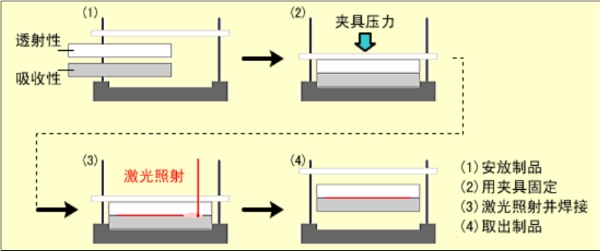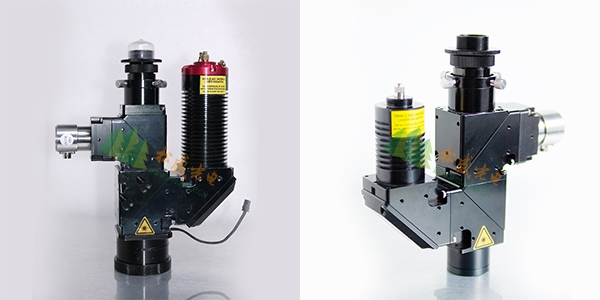Advantages and Process Flow of Laser Plastic Welding
With the advancement of laser welding technology and the reduction in laser equipment costs, laser plastic welding is gradually replacing traditional welding methods. Due to its high efficiency, precision, and environment friendliness, this technology has been widely adopted across various industries including automotive manufacturing, medical devices, and packaging.
The process primarily utilizes laser transmission or absorber-assisted methods to weld plastic materials, enabling seamless joining of different plastic components. In this article, Songsheng Optoelectronics provides a brief introduction to the advantage and process flow of laser plastic welding.

Laser Plastic Welding Process Diagram (Flow: Place product → Fixture clamping → Laser irradiation welding → Remove finished product)
Compared with traditional plastic welding methods, laser plastic welding offers the following unique advantages:
Non-contact Process: As a non-contact welding method, it involves no physical contact or chemical reactions with the workpiece. Suitable for industrial environments, it produces no dust or flash during welding, maintaining a clean workspace - making it ideal for hygiene-critical medical and food industries.
Precision Beam Control: The laser beam can be precisely shaped and sized through beam profiling, allowing accurate control of the heat-affected zone and joint area. This provides high flexibility with no restrictions on part dimensions or geometry, enabling both 2D and 3D welding for customized component solutions.
High Efficiency & Quality: Delivers fast welding speeds while producing high-strength seams with no flash or residue, ensuring excellent surface finish in the welded area.
Hermetic & Robust Joints: Creates precision, airtight, and watertight bonds that significantly reduce thermal and vibrational stresses - particularly suitable for delicate electronic components and fragile parts.
Laser Plastic Welding Process Overview
I. Laser Selection
The laser source should be selected based on the plastic material type, thickness and required output power. Different lasers offer varying power outputs, wavelengths and beam qualities that must match specific application requirements. Typically, 976nm and 2μm wavelength lasers are suitable for plastic welding applications.
II. Laser Parameter Configuration
Critical parameters include laser power, pulse width, frequency and beam focal length. These settings directly affect weld quality. For instance, while increasing laser power enhances penetration depth, it may also cause excessive melting or deformation. Precise parameter optimization is therefore essential for optimal results.
III. Focal Position Adjustment
Proper focal positioning is critical for weld quality. Incorrect positioning may lead to insufficient penetration or excessive weld width. Optimal focus is typically maintained at the material surface for best performance.
IV. Speed Control
Welding speed significantly impacts both quality and efficiency. Excessive speed may cause inadequate penetration, while insufficient speed risks material deformation. Speed must be precisely calibrated according to material properties, thickness and laser parameters.
V. Temperature Management
The material's melting point and thermal expansion coefficient critically influence weld outcomes. Precise temperature control maintains material stability during processing, preventing overheating or excessive cooling. This control also mitigates thermal stress concentration and distortion issues.

976nm Laser Welding Head (Left) | 2μm Plastic Welding Head (Right)
Key Advantages of Songsheng Opto's Laser Plastic Welding Technology:
Optimized Thermal Control
Utilizes high-energy-density laser heating to achieve precise temperature management at plastic joint interfaces, ensuring both high-speed processing and micron-level accuracy.
Minimized Heat Impact
Adjustable laser beam profiles confine the heat-affected zone (HAZ) to sub-millimeter levels, producing invisible seams with zero surface marring or structural damage.
Multi-Wavelength Flexibility
976nm/2μm dual-wavelength options with integrated CCD coaxial temperature monitoring enable real-time thermal regulation during welding.
Design Freedom
Eliminates geometric constraints on components, enabling revolutionary design possibilities for complex plastic assemblies.
Vibration-Free Processing
Ideal for delicate electronics and medical devices where mechanical stress must be avoided (compatible with components requiring <0.1g vibration tolerance).
Aseptic Non-Contact Operation
Maintains sterile conditions for medical/food applications through physical separation between energy source and workpiece (meets ISO 13485 & FDA Class II standards).
Automation-Ready
Robotic integration capabilities through flexible beam delivery systems (compatible with 6-axis robotic arms and PLC controls).
Contact: Mr.Xiao
Phone: +86-13385280662
E-mail: market001@whlaser.cn
Add: Room 02, Floor 5, Building 9, Gezhouba Sun City, No. 40, Gaoxin 4th Road, Donghu New Technology Development Zone, Wuhan